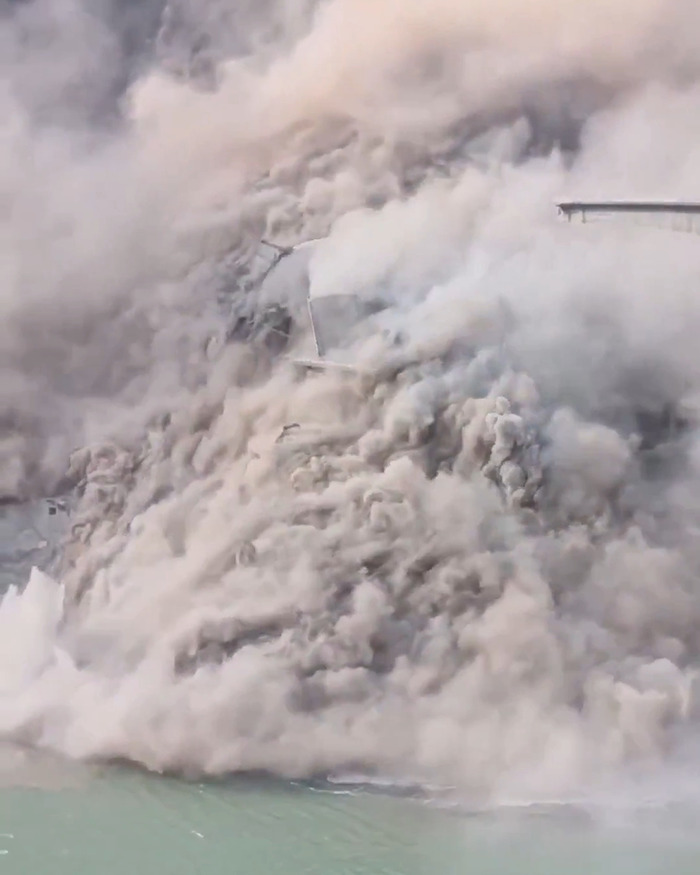A recently built bridge in China has collapsed just months after opening, stunning citizens and raising questions over the safety of the country’s rapid infrastructure expansion.
The 2,487-foot Hongqi Bridge, which connects Sichuan province with Tibet as part of a national highway, came crashing down on Tuesday morning (November 11) after a landslide struck the mountainous area, sending concrete slabs and debris plummeting into a river below.
The impactful images of the collapse soon went viral, showing the bridge folding in on itself amid a thick cloud of dust.
Authorities confirmed that there were no casualties, as the bridge had been closed a day earlier, but viewers are already sharing theories about the true nature of the disaster.
One of China’s most ambitious bridges collapsed mere months after opening

Image credits: HighestBridges
Local police in the Sichuan city of Ma’erkang, also known by its Tibetan name Barkam, had already shut down traffic on Monday afternoon after engineers noticed structural warning signs on the slopes and roads above the bridge.
“The slopes were showing visible deformation,” a local government statement said.
“The situation worsened on Tuesday, leading to a massive landslide that caused the bridge to fracture and collapse.”

Image credits: TaraBull
The footage shows the structure’s middle section giving way as the landslide hits, its long concrete span snapping like a twig before crashing into the valley below.
The Hongqi Bridge had only been completed earlier this year, and was supposed to be a vital route connecting Sichuan’s heartland to the Tibetan plateau. Now, its skeletal remains lie in the river it once crossed.
For critics, its ruin is symbolic of China’s infrastructure boom, characterized by speed and scale over long-term safety.
The collapse is the latest in a string of infrastructure failures across China’s rapidly expanding transportation network

Image credits: TaraBull
For instance, in July 2024, a highway bridge in Shaanxi province partially collapsed, taking the lives of at least 11 people.
In 2022, a building collapsed in Changsha, central China, with a fatality toll of 26 residents. The tragedy resulted in the arrest of at least 9 individuals connected with its construction on suspicion of ignoring safety regulations.

Image credits: TaraBull
The collapse of the Honqi Bridge, on the other hand, appears to have been the result of a combination of unfavorable terrain conditions.

Image credits: stopthepresslib

Image credits: DilksData
Sichuan itself sits on one of China’s most unstable fault zones, where the 2008 Wenchuan earthquake ended more than 69,000 people’s lives.
Experts say that the terrain, combined with heavy rainfall and steep gradients, makes large-scale construction particularly risky.

Image credits: HighestBridges
The Hongqi Bridge was allegedly designed to withstand such conditions, but its destruction just months after completion has raised many questions about planning and oversight in China’s multi-billion-dollar infrastructure push.
Netizens questioned the decision to build the bridge in a geologically volatile area prone to landslides

Image credits: HighestBridges
Online, users debated what might have caused the failure.
“Apparently slope deformation, so perhaps less a structural issue than a planning one,” one commenter wrote in an engineering forum.
“So basically the slope that the bridge was constructed on deformed from the weight and caused the bridge to collapse?” another user asked.

Image credits: ArashBayatpour

Image credits: SpatialPhysics
A user, identifying themselves as a civil engineer, gave a more detailed explanation:
“The ground at the toe, the edge between walls and floor, failed, creating a cavity that traveled uphill. The mass of earth broke the anchoring, allowing the deck to start moving sideways. Bridges aren’t designed to move like that.”
In other words, the foundation beneath the bridge, not the bridge itself, appears to have given way.

Image credits: HighestBridges
The exact cause remains under investigation by Sichuan authorities, but experts suggest that poor slope stabilization or inadequate geological surveying may have played a role.
The Ministry of Transport has sent inspection teams to assess the damage and determine whether other nearby structures could be at risk. For now, the entire section of the highway connecting Sichuan and Tibet remains closed.
Despite the lack of casualties, the collapse has become a national talking point, especially given that it was meant to symbolize the strength and unity of China’s western development projects.
“Horrific.” Netizens were relieved to learn that no one was hurt during the bridge’s collapse

Image credits: jessestand9

Image credits: BWay124

Image credits: Goldenmom1007

Image credits: Glenn_sccc

Image credits: QT_JAAN

Image credits: EBTtok

Image credits: Quest4Truth25

Image credits: brosteve77

Image credits: N0vaPGL

Image credits: wolliswolf93361

Image credits: THext93951

Image credits: HistorianUSA1

Image credits: animadigitalis

Image credits: Whitman14Holly

Image credits: Hustlersmanu

Image credits: DavidGabreel2
 Follow Us
Follow Us




